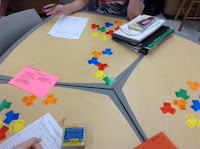 Last year I did a lot of writing about asking students to draw models of particles to demonstrate their understanding of chemical concepts. I started this about ten years ago with my PLC and I always gain insight into my students' ideas when I look at their drawings. Drawing has become a regular part of my chemistry class and is incorporated on almost every test.
Last year I did a lot of writing about asking students to draw models of particles to demonstrate their understanding of chemical concepts. I started this about ten years ago with my PLC and I always gain insight into my students' ideas when I look at their drawings. Drawing has become a regular part of my chemistry class and is incorporated on almost every test.
To that end, last week my students read about the classification of matter (elements, compounds, and mixtures). The next day in class they took an open-note quiz. I provided particle pictures and they had to answer questions about the pictures, like "Which one represents a mixture of two elements?" and so on. I have done something similar in past years as a check of their reading comprehension. What follows has been a guided notes activity and some demonstrations for extra emphasis. This year, instead, I split the students into three groups based on their quiz scores and provided differentiated learning experiences.
 Group 1 had scores that were 60% or lower. These students completed the guided notes activity on iPads. Students tapped their way through a Keynote presentation and answered questions about particle pictures as they viewed. When they finished, they had a quick model building exercise where they filled small cups with models to represent samples of matter. When the cups were assembled, I checked the cups visually and corrected misconceptions.
Group 1 had scores that were 60% or lower. These students completed the guided notes activity on iPads. Students tapped their way through a Keynote presentation and answered questions about particle pictures as they viewed. When they finished, they had a quick model building exercise where they filled small cups with models to represent samples of matter. When the cups were assembled, I checked the cups visually and corrected misconceptions. Group 2 played a great game called TriConnect by Scienterrific Games. In this domino-esque game, cards are distributed evenly among players and have to be matched in turn by properties of a sample of matter. The students who played the game scored 70-80% on the quiz, so they were practicing what they knew and extending their knowledge with this game. The conversations as they played were excellent.
Group 2 played a great game called TriConnect by Scienterrific Games. In this domino-esque game, cards are distributed evenly among players and have to be matched in turn by properties of a sample of matter. The students who played the game scored 70-80% on the quiz, so they were practicing what they knew and extending their knowledge with this game. The conversations as they played were excellent. Group 3 performed an experiment. These students had demonstrated mastery on the quiz, so their work was an extension of our content. The lab was the chemistry standard of aluminum mixed with copper(II) chloride solution, but students were looking through the lens of a particle model of chemistry.
Group 3 performed an experiment. These students had demonstrated mastery on the quiz, so their work was an extension of our content. The lab was the chemistry standard of aluminum mixed with copper(II) chloride solution, but students were looking through the lens of a particle model of chemistry.
If someone would have told me a year ago that I would be managing three different simultaneous activities, where one was a lab involving chemicals, I would have balked, but the management piece was not as difficult as I imagined. The lab was short, so I had plenty of time to circulate among the three groups to offer help and clarification but also be vigilant as the chemicals were used. In the past, everyone had the guided notes whether they needed them or not. This year, students who showed they understood the content got to have a unique practice opportunity in the lab while students who were on the verge participated in a game to make practice more fun. For students who needed the guided notes, they were still available with the added model activity to check for understanding. The collaborative nature of the activities and groupings facilitated engaged, focused work.
The following day everyone worked in the lab, so every student still practiced these skills in the lab. In fact, the lab was due on the test review day and we had a lively discussion of particle models as we reviewed for the test. A quick look at yesterday's tests leads me to believe that the practice paid off, so I am looking for more ways to incorporate activities like these into my practice this year.
No comments:
Post a Comment